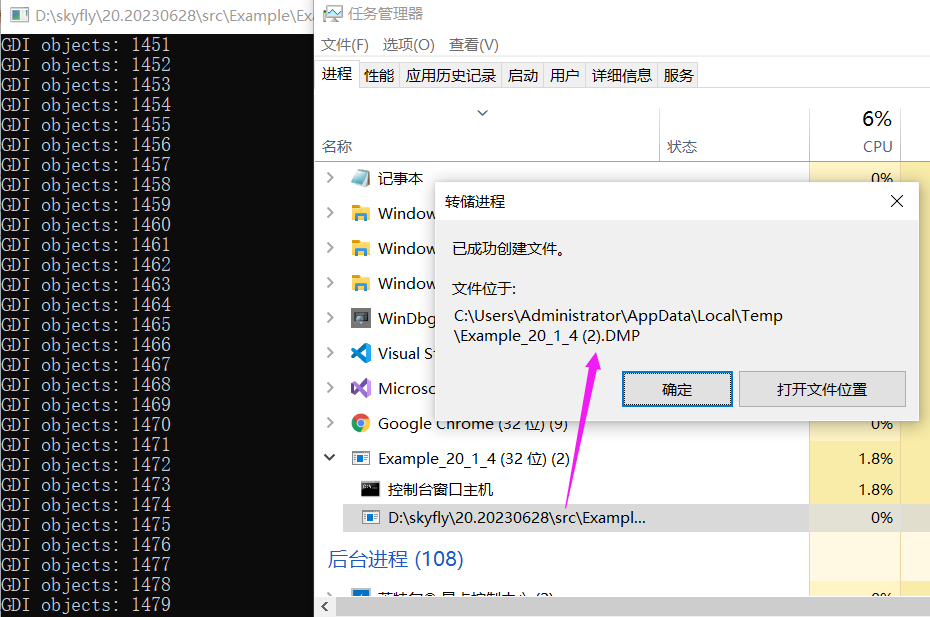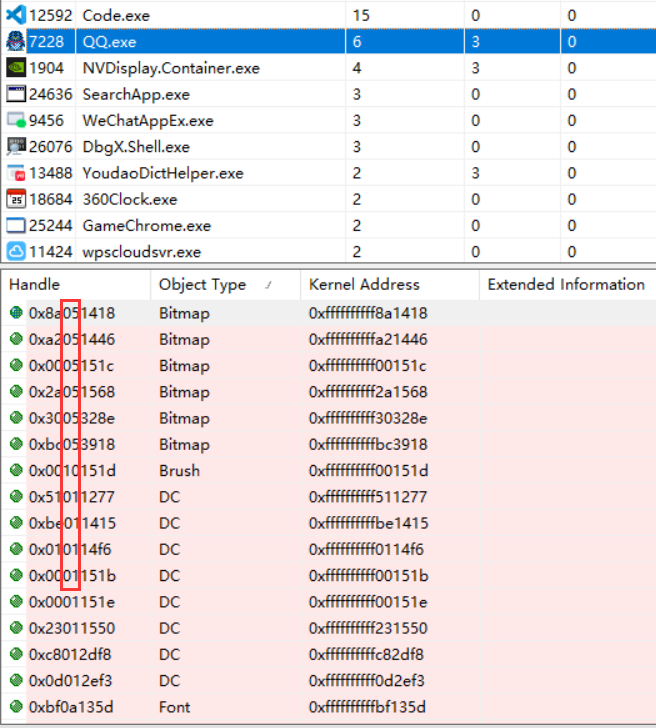.NET程式的 GDI控制程式碼洩露 的再反思
一:背景
1. 講故事
上個月我寫過一篇 如何洞察 C# 程式的 GDI 控制程式碼洩露 文章,當時用的是 GDIView + WinDbg 把問題搞定,前者用來定位洩露資源,後者用來定位洩露程式碼,後面有朋友反饋兩個問題:
- GDIView 統計不準怎麼辦?
- 我只有 Dump 可以統計嗎?
其實那篇文章也聊過,在 x64 或者 wow64 的程式裡,在使用者態記憶體段中有一個 GDI Shared Handle Table 控制程式碼表,這個表中就統計了各自控制程式碼型別的數量,如果能統計出來也就回答了上面的問題,對吧。
32bit 程式的
GDI Shared Handle Table段是沒有的,即_PEB.GdiSharedHandleTable = NULL。0:002> dt ntdll!_PEB GdiSharedHandleTable 01051000 +0x0f8 GdiSharedHandleTable : (null)
有了這些前置基礎,接下來就可以開挖了。
二:挖 GdiSharedHandleTable
1. 測試程式碼
為了方便測試,我來造一個 DC控制程式碼 的洩露。
internal class Program
{
[DllImport("Example_20_1_5", CallingConvention = CallingConvention.Cdecl)]
extern static void GDILeak();
static void Main(string[] args)
{
try
{
GDILeak();
}
catch (Exception ex)
{
Console.WriteLine(ex.Message);
}
Console.ReadLine();
}
}
然後就是 GDILeak 的 C++ 實現程式碼。
extern "C"
{
_declspec(dllexport) void GDILeak();
}
void GDILeak()
{
while (true)
{
CreateDCW(L"DISPLAY", nullptr, nullptr, nullptr);
auto const gdiObjectsCount = GetGuiResources(GetCurrentProcess(), GR_GDIOBJECTS);
std::cout << "GDI objects: " << gdiObjectsCount << std::endl;
Sleep(10);
}
}
程式跑起來後,如果你是x64的程式那沒有關係,但如果你是 32bit 的程式一定要生成一個 Wow64 格式的 Dump,千萬不要抓它的 32bit dump,否則拿不到 GdiSharedHandleTable 欄位也就無法後續分析了,那如何生成 Wow64 格式的呢?我推薦兩種方式。
-
使用64bit工作管理員(系統預設)生成
-
使用 procdump -64 -ma QQ.exe 中的 -64 引數
這裡我們採用第一種方式,截圖如下:

2. 分析 GdiSharedHandleTable
使用偽暫存器變數提取出 GdiSharedHandleTable 欄位,輸出如下:
0:000> dt ntdll!_PEB GdiSharedHandleTable @$peb
+0x0f8 GdiSharedHandleTable : 0x00000000`03560000 Void
接下來使用 !address 找到這個 GdiSharedHandleTable 的首末地址。
0:000> !address 0x00000000`03560000
Usage: Other
Base Address: 00000000`03560000
End Address: 00000000`036e1000
Region Size: 00000000`00181000 ( 1.504 MB)
State: 00001000 MEM_COMMIT
Protect: 00000002 PAGE_READONLY
Type: 00040000 MEM_MAPPED
Allocation Base: 00000000`03560000
Allocation Protect: 00000002 PAGE_READONLY
Additional info: GDI Shared Handle Table
Content source: 1 (target), length: 181000
上一篇我們聊過每新增一個GDI控制程式碼都會在這個表中增加一條 GDICell,輸出如下:
typedef struct {
PVOID64 pKernelAddress;
USHORT wProcessId;
USHORT wCount;
USHORT wUpper;
USHORT wType;
PVOID64 pUserAddress;
} GDICell;
這個 GDICell 有兩個資訊比較重要。
wProcessId表示程序 IDwType表示控制程式碼型別。
理想情況下是對 控制程式碼型別 進行分組統計就能知道是哪裡的洩露,接下來的問題是如何找呢?可以仔細觀察結構體, wProcessId 和 wType 的偏移是 3USHORT=6byte,我們在記憶體中找相對偏移不就可以了嗎?接下來在記憶體中搜尋這塊
0:000> ~.
. 0 Id: 101c.4310 Suspend: 0 Teb: 00000000`009bf000 Unfrozen
Start: Example_20_1_4_exe!wmainCRTStartup (00000000`00d4ffe0)
Priority: 0 Priority class: 32 Affinity: fff
0:000> s-w 03560000 036e1000 101c
00000000`03562060 101c 0000 af01 0401 0b00 0830 0000 0000 ..........0.....
00000000`035782a0 101c ff1d ffff ffff 0000 0000 1d0f 010f ................
00000000`0357c688 101c 0000 3401 0401 0160 0847 0000 0000 .....4..`.G.....
...
00000000`035a5f98 101c 0000 0801 0401 0dc0 08a1 0000 0000 ................
00000000`035a5fb0 101c 0000 0801 0401 0c60 08a1 0000 0000 ........`.......
00000000`035a5fc8 101c 0000 0801 0401 0840 08a1 0000 0000 ........@.......
00000000`035a5fe0 101c 0000 0801 0401 0b00 08a1 0000 0000 ................

從卦中可以看到,當前有1029個 GDICell 結構體,接下來怎麼鑑別每一條記錄上都是什麼型別呢?其實這裡是有列舉的。
- DC = 0x01
- Region = 0x04
- Bitmap = 0x05
- Palette =0x08
- Font =0x0a
- Brush = 0x10
- Pen = 0x30
即 GDIView 中的 紅色一列 。

到這裡我們可以通過肉眼觀察 + F5 檢索,可以清晰的看到1029 個控制程式碼物件,其中 1028 個是 DC 物件,其實這就是我們洩露的,截圖如下:

3. 指令碼處理
如果大家通讀會發現這些都是固定步驟,完全可以寫成比如 C++ 和 Javascript 的格式指令碼,在 StackOverflow 上還真有這樣的指令碼。
$$ Run as: $$>a<DumpGdi.txt
$$ Written by Alois Kraus 2016
$$ uses pseudo registers r0-5 and r8-r14
r @$t1=0
r @$t8=0
r @$t9=0
r @$t10=0
r @$t11=0
r @$t12=0
r @$t13=0
r @$t14=0
$$ Increment count is 1 byte until we find a matching field with the current pid
r @$t4=1
r @$t0=$peb
$$ Get address of GDI handle table into t5
.foreach /pS 3 /ps 1 ( @$GdiSharedHandleTable { dt ntdll!_PEB GdiSharedHandleTable @$t0 } ) { r @$t5 = @$GdiSharedHandleTable }
$$ On first call !address produces more output. Do a warmup
.foreach /pS 50 ( @$myStartAddress {!address @$t5} ) { }
$$ Get start address of file mapping into t2
.foreach /pS 4 /ps 40 ( @$myStartAddress {!address @$t5} ) { r @$t2 = @$myStartAddress }
$$ Get end address of file mapping into t3
.foreach /pS 7 /ps 40 ( @$myEndAddress {!address @$t5} ) { r @$t3 = @$myEndAddress }
.printf "GDI Handle Table %p %p", @$t2, @$t3
.for(; @$t2 < @$t3; r @$t2 = @$t2 + @$t4)
{
$$ since we walk bytewise through potentially invalid memory we need first to check if it points to valid memory
.if($vvalid(@$t2,4) == 1 )
{
$$ Check if pid matches
.if (wo(@$t2) == @$tpid )
{
$$ increase handle count stored in $t1 and increase step size by 0x18 because we know the cell structure GDICell has a size of 0x18 bytes.
r @$t1 = @$t1+1
r @$t4 = 0x18
$$ Access wType of GDICELL and increment per GDI handle type
.if (by(@$t2+6) == 0x1 ) { r @$t8 = @$t8+1 }
.if (by(@$t2+6) == 0x4 ) { r @$t9 = @$t9+1 }
.if (by(@$t2+6) == 0x5 ) { r @$t10 = @$t10+1 }
.if (by(@$t2+6) == 0x8 ) { r @$t11 = @$t11+1 }
.if (by(@$t2+6) == 0xa ) { r @$t12 = @$t12+1 }
.if (by(@$t2+6) == 0x10 ) { r @$t13 = @$t13+1 }
.if (by(@$t2+6) == 0x30 ) { r @$t14 = @$t14+1 }
}
}
}
.printf "\nGDI Handle Count %d", @$t1
.printf "\n\tDeviceContexts: %d", @$t8
.printf "\n\tRegions: %d", @$t9
.printf "\n\tBitmaps: %d", @$t10
.printf "\n\tPalettes: %d", @$t11
.printf "\n\tFonts: %d", @$t12
.printf "\n\tBrushes: %d", @$t13
.printf "\n\tPens: %d", @$t14
.printf "\n\tUncategorized: %d\n", @$t1-(@$t14+@$t13+@$t12+@$t11+@$t10+@$t9+@$t8)
最後我們用指令碼跑一下,哈哈,是不是非常清楚。
0:000> $$>a< "D:\testdump\DumpGdi.txt"
GDI Handle Table 0000000003560000 00000000036e1000
GDI Handle Count 1028
DeviceContexts: 1028
Regions: 0
Bitmaps: 0
Palettes: 0
Fonts: 0
Brushes: 0
Pens: 0
Uncategorized: 0
三:總結
如果大家想從 DUMP 檔案中提取 GDI 控制程式碼洩露型別,這是一篇很好的參考資料,相信能從另一個角度給你提供一些靈感。
